Lithium extraction from the world’s largest salt lake:
Destruction in a green jacket
Climate ambitions do not take into account the irrevocable consequences of mining. In northern Chile, an ancient ecosystem and a 12,000-year-old culture are being sacrificed. Is climate policy destroying the very thing it would repair?
by
Darko Lagunas and Prof. Dr. med. Robert Gorter
(with thanks to the Dutch Groene Amsterdammer)
June 21st, 2023
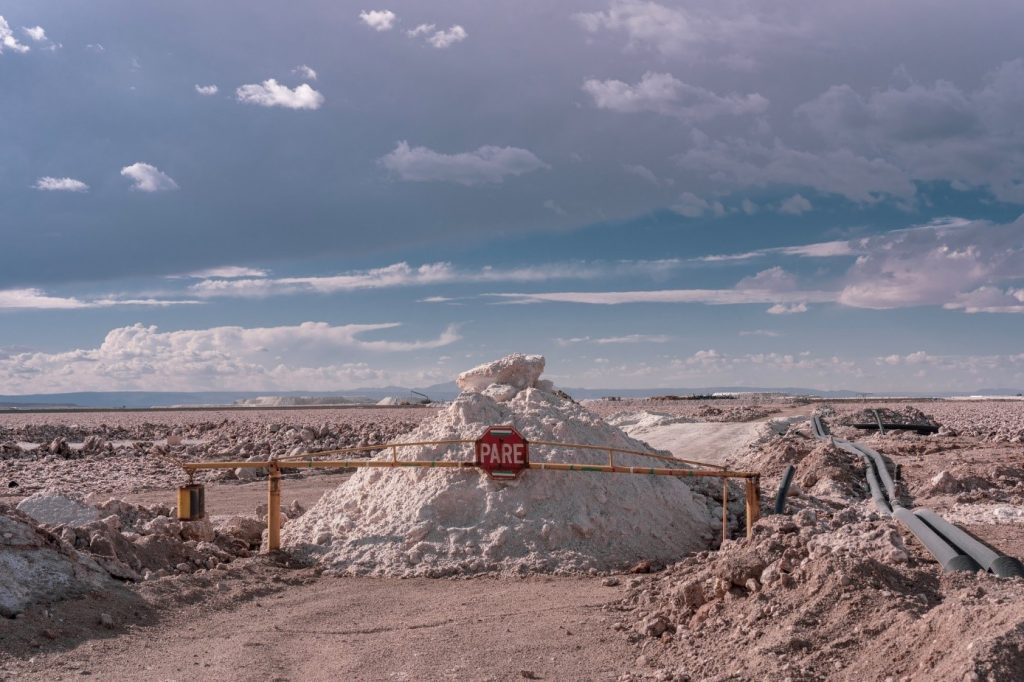
Road cordon with residual waste from the Albemarle lithium mine, with pipes on the right pumping underground fossil water to the evaporation pools
It’s the rainy season in the world’s driest ecosystem. The “Bolivian Winter” brings rare rainfall to the high plains of Chile’s Atacama Desert. When I get there, the water is pouring down from the sky in buckets. A strange sensation in the desert, especially because it rains less and less due to climate change. Essential water reservoirs are very difficult to replenish. Yet that is not the greatest threat to existence in this area.
I met Carlos Vega through a good acquaintance from Santiago. He is 49 years old and lives with his family in Coyo, a small Lickanantay community in the north of the Salar de Atacama. The Lickanantay are an indigenous culture whose oldest archaeological finds in the Atacama Desert date back over twelve thousand years. From hunter-gatherers, the Lickanantay have evolved into farmers and pastoralists through strong adaptability and regular interaction with neighboring groups from southern Bolivia and northern Argentina. To survive here, the common use of limited resources is crucial. More than 2400 meters above sea level, with one of the most unforgiving climates on earth, the Lickanantay have managed to produce food with sophisticated knowledge and technologies and with very scarce water.
That scarce water is now at stake. “We were here long before the Incas and now our very existence and the traditions of our ancestors are under threat,” says Vega. “The water is the basis of life and the scale at which it is being extracted is a threat to us, our animals, and the land we feed.”
The water from the river basin drains into the Salar de Atacama basin. With an area of three thousand square kilometers (larger than the province of Zeeland), it is one of the world’s largest salt lakes. For thousands of years this salt lake, which ecologists call a wetland despite its dry climate, has been an important refuge for the Lickanantay and an oasis of biodiversity.
The mineral wealth in the Atacama has attracted much attention since the late nineteenth century. Chile fought the saltpeter war with neighboring countries Peru and Bolivia and thus conquered the area where more and more large-scale mining has been moving since the 1980s. First for saltpeter, then for copper, and now also for lithium for electric vehicles. All these mega-industries lay claim to the few water resources in the area.
“This area has turned into a sacrifice zone,” explains Vega. ‘In some places, the water level has dropped by two meters. And they’ve already completely drained the water from the Salar de Punta Negra.’
During our first meeting, we are sitting in Vega’s backyard, which looks a lot like a botanical garden. In the middle of the driest desert in the world, forests of mint, all colors of corn, and a pharmacy of medicinal plants grow here. Carefully, Vega explains the working forces of each plant. It gets dark quickly and with every sentence he utters, I see him less well.
The Salar de Punta Negra, south of the Salar de Atacama, was drained between 1990 and 2017 by the Escondida mine: the world’s largest copper mine owned by Australian BHP. In 2021, the mining company was found responsible by Chile’s first environmental tribunal. BHP may have to pay more than $90 million in compensation, but the mine is still operating at full capacity and is now pumping water from other watersheds.
The Escondido Mine is just one of many mines in the area. The Salar de Atacama is surrounded by huge open pit mines owned by Lomas Bayas, owned by the American company Glencore, and Gabriela Mistral and Chuquicamata by Chilean copper producer Codelco. The salt lake itself is home to the largest lithium producers in the world, the American Albemarle and the Chilean SQM.
The largest shareholder of the Chilean SQM is Julio Ponce Lerou, the ex-son-in-law of Augusto Pinochet, whose wealth was made possible by the privatization of state-owned enterprises during the dictator’s rule (1973-1990).
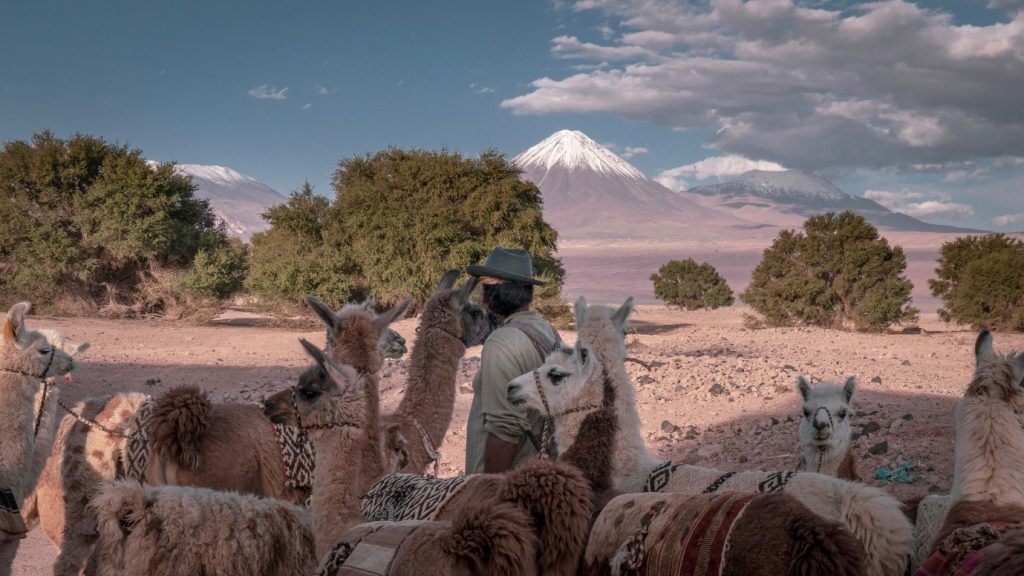
Mining critic Carlos Vega with his llamas, overlooking the Lascar Volcano, which has an important significance for the Lickanantay community as a guardian of the area’s water
On the Salar de Atacama, SQM and Albemarle together pump roughly two thousand liters of water per second from the groundwater; 95 percent of all that water is evaporated in large basins (evaporation basins), after which the remaining lithium and other non-metallic minerals can be ‘harvested’. The amount of water pumped out is at least 21 percent more than the salt lake can handle, given the natural water supply, according to two independent studies. With increasing production and a lack of environmental legislation, that figure can only increase.
‘The Salar de Atacama is a water basin. If you pump water from one side of a reservoir, it affects everyone,’ says Vega.
The presence and impact of mining have left local communities around the Salar de Atacama in a tight spot. Vega explains how some ten years ago it was inevitable for a then-Lickanantay president to enter into talks with the mining companies.
For example, in 2017 the Council of Atacama Communities (Consejo de Pueblos Atacameños, CPA ) CAME TO AN AGREEMENT WITH THE THEN ROCKWOOD LITHIUM, THE AMERICAN MINING COMPANY NOW KNOWN AS ALBEMARLE. Since then, the CPA has received a small percentage of profit from Albemarle as compensation, which is distributed to projects that benefit Lickanantay communities.
I get in touch with Manuel Salvatierra, ex-president of the council. He recently resigned from his duties. “There comes a time when you have to pay attention to your family. I’m focusing on my personal life for now,” he says. In the shade of an algarrobo (carob tree) we shelter from the burning sun. Salvatierra (literally translated as ‘earth-savior’) explains the complicated role of the council.
The CPA stands for preserving the Lickanantay culture and protecting the area from outside influences. Illustrative of the work of the CPA was their contribution during COP 25 in Madrid when they made the statement that there is no sustainable mining in the Atacama and that the Lickanantay do not want to be the medium of exchange for the development of green economies.
However, the treaty that the CPA concluded with Albemarle has caused much criticism of the role of the CPA . “You have to imagine that this is one of the areas where most of the minerals come from,” says Salvatierra. ‘Copper, rare earths, lithium, saltpeter. But we see nothing of this wealth. In terms of public facilities, health care, energy supplies and running water, the Chilean government is completely absent.’
According to Salvatierra, after more than thirty years of mining in the area, no dialogue with the government has been possible. ‘That is why we, as Lickanantay communities, have entered into a dialogue with the mining companies. As a last resort, and as a way to return dignity and self-determination to the communities.’ Before that time, the Lickanantay communities did not exist for the mining companies.
The dominance of mining in the area explains the absence of government, according to Salvatierra. The idea is that there is no life in a desert. And where there is no life, no rights, no government or public facilities are needed. But the reality is different. So mining dollars are filling an important vacuum left by the government, says Salvatierra. “Thanks to this money, the communities are doing well, unlike in other areas. We can now create the public facilities we need ourselves.’
Green promises from politicians bulldoze the interests of the local population
The treaty the CPA signed with Albemarle is very lucrative. Thanks to the booming lithium industry, Albemarle had 14 times more revenue last year than the previous year. ‘Before you win a lottery you have no idea what the effect of so much money will be. We are in the same process,” says Salvatierra.
That’s the crux of the problem, according to critics, who see mining dollars as a threat to their way of life. Carlos Vega is one of these people and often sighs that nowadays everything is all about money. Communal meetings are no longer about the land, the water, or the way the Lickanantay sees the world, but about money.
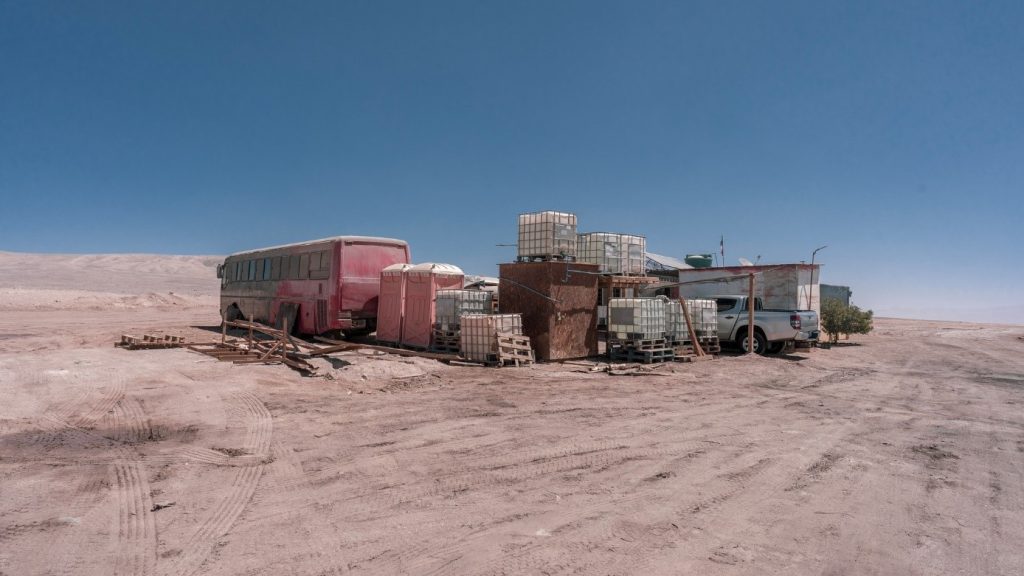
Roadhouse on the mining route from the high plains to the ports of Mejillones and Tocopilla, where ships are loaded with resources from the bottom of the Atacama Desert
Via Zoom I meet with Chilean Bárbara Jerez Henríquez, a postdoctoral fellow in the political ecology of lithium at the University of Concepción. She did a lot of research on the socio-ecological impact of mining in the area. “For the communities, it was initially a survival strategy,” she explains. “But money from mining has always been a strategy for the companies to undermine and divide communities. The original relationships between communities are marketed and ‘bureaucratized’.’
Jerez Henriquez calls it the introduction of Western, neoliberal logic. It keeps people busy and takes up precious time that was previously used to maintain community relations.
In the West, we know no different, but Carlos Vega helps with an example. During our second meeting, we sit in the shade of an old Camargo tree while Vega’s goats and llamas walk around us. In the distance, the Lascar volcano stands out against a typical pink-blue sky of a highland eve.
‘We have traditionally lived together on the land,’ he says. ‘It takes more than a day to sow a piece of land and then there are times when you have to hide from the heat or wait for the animals. That is precious time spent together talking about how you are doing, your family, or the country ahead. This time is essential to building community and relationships. With the money came the tractor, then at the end of the day a short conversation is all you share.’
In addition, the generation of young people who have to keep the Lickanantay culture alive is contracted by the mining industry. ‘Our young people are lured by the quick money they can earn in the mines.’ Vega speaks from experience. He himself worked in the lithium mine. The conditions were harsh and sometimes inhumane. ‘You then work night shifts seven days in a row and sleep during the day. In the middle of the salt lake with extreme heat in containers without air conditioning. So we slept on mattresses under the containers for some fresh air. But you can earn a relatively large amount of money.’ When they have time off, young people then have no time to work the land and prefer to do their shopping in the shopping center of Calama, a two-hour drive away.
A break in the relationship with the landscape is also a break with valuable traditions. Knowledge transfer and barter with scarce resources gave way to discussions about money. What was historically a cornerstone of the Lickanantay identity is disappearing through a new reality being imposed. Now the corridor to the shopping center has replaced it. It is a form of ethnocide, explains Chilean Jerez Henríquez. ‘Talking, practicing, and transferring knowledge is fundamental to life in indigenous communities where knowledge is mainly passed on orally. Now that millions of dollars are flowing into communities through the CPA, those days are gone.
A modern capitalist world may or may not be forcibly introduced. Where distrust and money increasingly play the leading role and nature is only a resource of “progress”. As a result, a culture with more than twelve thousand years of experience and traditions can disappear forever.’
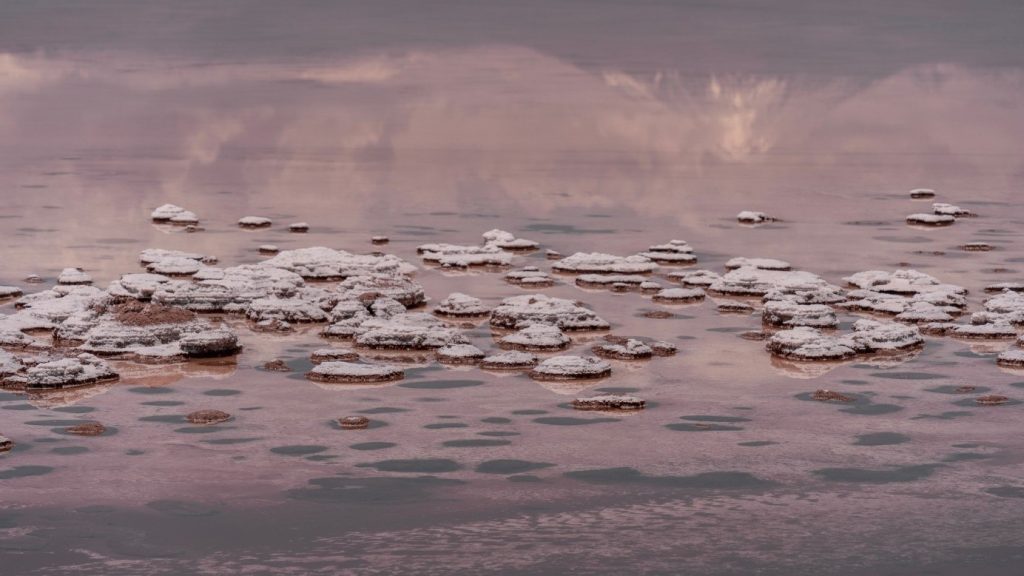
Laguna Tebenquiche, where microbial mats and rock structures are inhabited by organisms living under extreme conditions. The mats have a pink tint and a brain-like shape. The lagoon is located in the middle of the Salar de Atacama salt lake, from which lithium companies pump more than two thousand liters of water per second.
This has everything to do with the climate ambitions in the northern hemisphere. For example, the President of the European Commission, Ursula von der Leyen, announced in March 2023 that ‘the race is on to determine who will dominate the clean technology market in the future’. It is the tone of the geopolitical battle going on in the field of critical transition minerals.
An important step that the EU made in this fight is a new trade agreement with Chile, which was signed at the end of December 2022. The treaty, which further liberalizes free trade between Chile and the EU, should improve European access to transition minerals such as lithium, copper, and hydrogen from Chile. With the world’s largest copper and lithium reserves, Chile (according to the US Geological Survey) is an important trading partner for the EU. Until 2040, the global demand for copper will grow five times ( according to the Chilean Ministry of Mines ) and the demand for lithium will grow by a significant five hundred percent until 2050 ( according to the World Bank ). This year alone, the lithium giant expects SQMa’s 40 percent growth in demand for lithium.
Business is booming. But while the treaty was announced by EU Vice-President Josep Borrell with words about common values such as sustainability and human rights, the EU does not want to pay taxes to Chilean citizens. In the geopolitical tug-of-war, Chilean citizens, particularly those experiencing the ecological impacts in the Atacama Desert, are losing out.
Because while the wealth of the Atacama fuels the energy transition in the Global North, power for local villages is generated by screeching petroleum generators. Water, polluted with heavy metals, only flows from the tap during the day and for drinking water you depend on mineral water from the supermarket. The first hospital is two to three hours away from the salt lake. The ‘beating heart of the mining industry’ is a few hours’ drive up the coast. Fifteen coal-fired power stations that generate electricity for ‘green’ mining are partly responsible for the highest number of people with lung cancer and respiratory problems in Chile. But who cares…..?
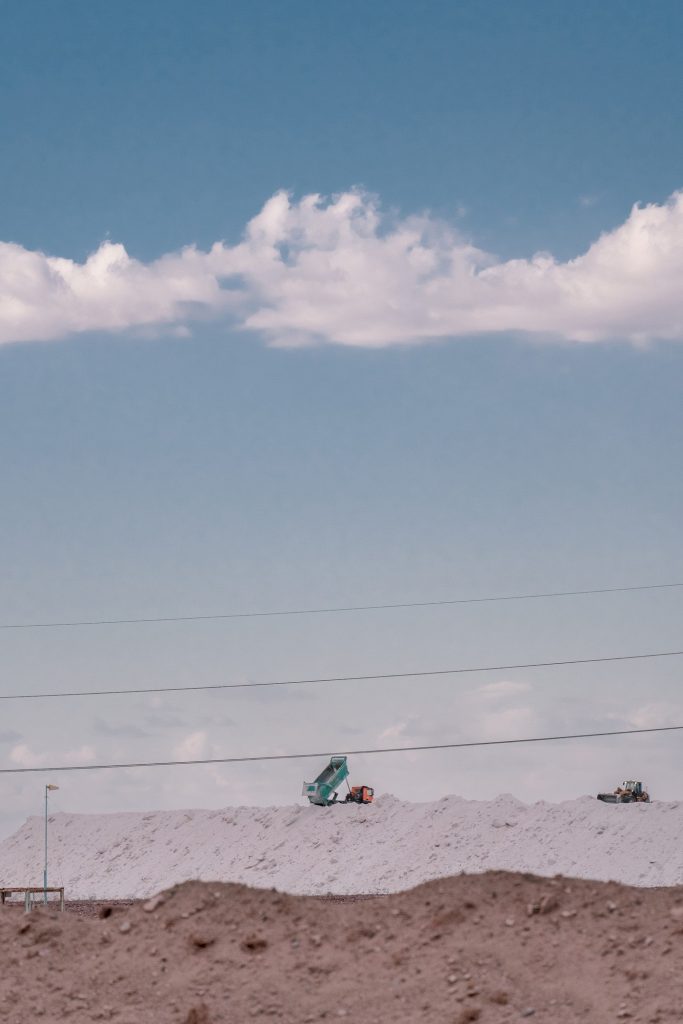
When all the water has evaporated, a layer of minerals remains from the brine that is ‘harvested’. This consists of potassium, lithium, salt, and other minerals. Trucks dump the stuff on great white mountains, after which it is collected for processing near the ports on the coast.
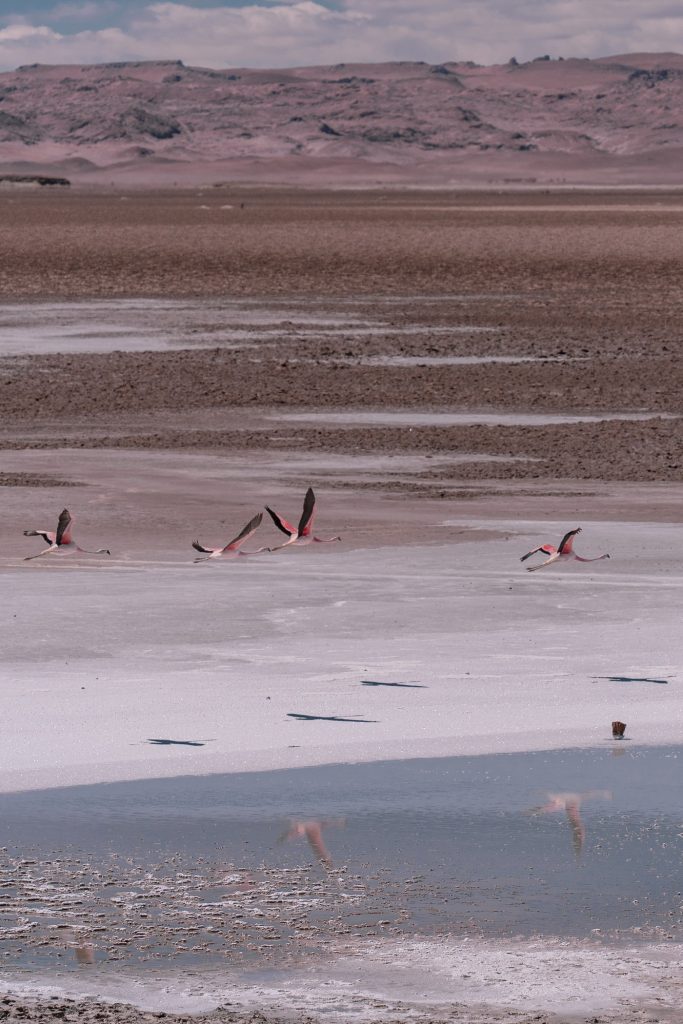
An elevated salt lake is under concession to Canadian mining company Wealth Minerals for lithium mining. These lakes are still part of the Reserva Nacional Los Flamencos and the environmental permits to open a mine are still missing. With the latest developments, that can change quickly.
This year (2023), the government of President Gabriel Boric announced two important measures. Nationalizing Chilean lithium and tightening environmental requirements for lithium mining. With the ‘National Lithium Strategy’ proposed by Boric, he wants to ‘increase Chilean wealth’. Not a crazy plan. SQM already made almost four billion in profit in 2022 alone. With the nationalization of lithium, a financial boost can be given to poor health care, education, housing, and other public facilities in the country. Now the implementation.
That already went wrong during the announcement of the plans. There was talk of the importance of coordination with the local population, while no dialogue of any kind took place with the Lickanantay communities or the CPA on government plans. The ILO Convention 169 on Indigenous Peoples, ratified by Chile, stipulates that these people must be consulted in advance when measures are taken that may directly affect them.
In addition, critics say the plans take a reductionist view of northern Chile’s ecosystems by categorizing 70 percent of salt lakes as “replaceable.” Only thirty percent will be protected. This opens the door for more sacrificial zones in the area for economic progress in Chile, without involving the local population.
Then the environmental requirements. In March this year, Boric announced that Chile does not want any more evaporation basins. Preference is given to more sustainable and less water-intensive forms of lithium extraction, such as ‘direct lithium extraction methods’ (DLE). I speak to Henk van Alphen about this technology, he is CEO of the Canadian mining company Wealth Minerals Ltd. which is far from the development of DLE. “With direct lithium extraction methods we pump almost all the water back, without lithium that is,” he says. ‘For example, we only use ten liters of water per second, compared to the two thousand liters of water consumed per SQUARE METER per second in the evaporation basins.’
With DLE, Van Alphen hopes to finally open a mine on the Salar de Atacama. After all, they have been working on this for years, without success. ‘They prefer to keep everything to themselves’, Van Alphen reproaches SQM and Albemarle while he paints a picture of House of Cards -like intrigues between powerful stakeholders on the salt lake and politics. “Let’s say the [conservative] Piñera administration was relatively close with Albemarle and SQM. Existing agreements that Wealth Minerals had concluded with Bachelet’s previous government were swept off the table by Piñera.’
Countries with an industrial lead always come out on top
Piñera is now one of the main suspects in the ‘ SQM case’ that started this year. The case came to light in late 2015 and investigates charges of corruption, bribery of politicians, and tax evasion by SQM. ‘The new Boric government is not nearly as in love with Albemarle and SQM,’ says Van Alphen. ‘With the new environmental requirements, they have a major problem to deal with. THE SQM license runs until 2030 and they do not want to have to invest in more sustainable technologies. After all, they only have seven years left, with no guarantee of renewal.’
Things look good for Wealth Minerals with the new environmental requirements. But the measures offer the local population little perspective. Environmental demands are mostly used as a crowbar in a competitive battle and nationalizing lithium seems to serve mainly the rural neoliberal economy while paving the way for more extraction. After all, there is a crushing global demand for lithium and green promises from European politicians are crushing the interests of the local population. “There are huge sources of income underground there. Nobody drinks that water. It would be a shame not to remove the lithium,’ says Van Alphen.
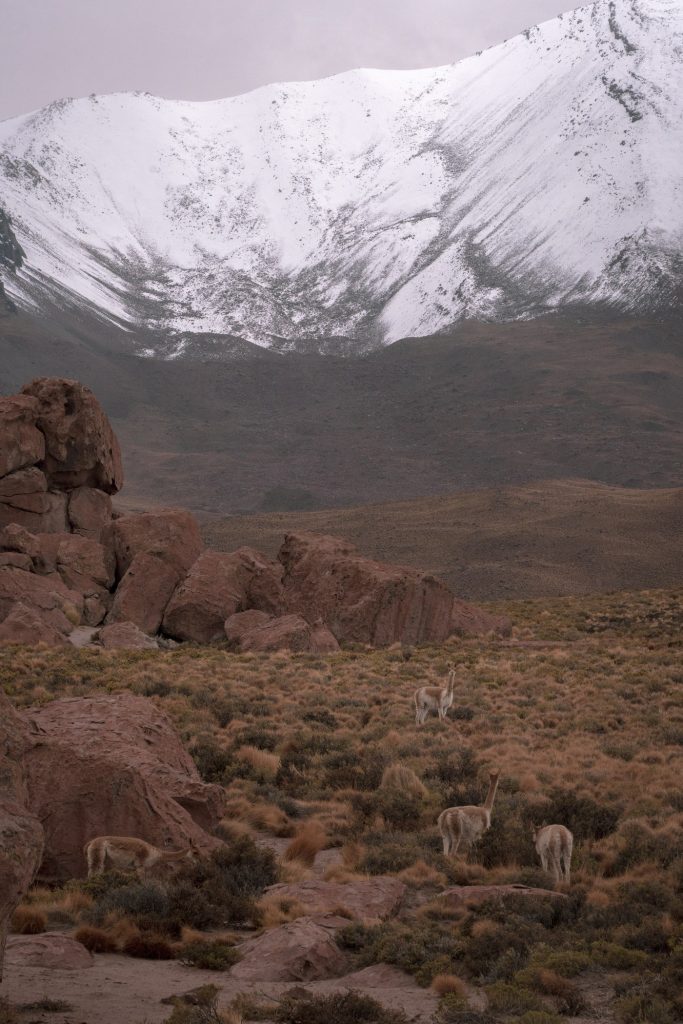
Vicuñas are one of the most common mammals on the high plateau. You will also encounter guanacos and viscachas (rabbits) and foxes, in addition to the famous flamenco. All biodiversity in the area depends on the scarce water resources.

Large quantities of sulfuric acid are transferred from trains to trucks in a remote location along the mining route (Baquedano). Sulfuric acid is needed in the many copper mines in the area and is used to separate copper ore from other rocks.
However, the ‘fossil water’ (brine) that Van Alphen refers to is vital for all biodiversity in this area, explains microbiologist Maria Farías. ‘This water with very high salt concentrations offers a unique habitat for the most primitive ecosystem on earth.’ Farías is co-author of the report Extremophiles and the Origin of Life in the Atacama. Thanks to the findings in the report, the Tebenquiche lagoon on the Salar de Atacama was declared a nature reserve. ‘The decisive result was the capacity of the microbes to produce oxygen. In percentage terms, this is more than one square meter of Amazon forest per square meter.’
The critters responsible for this are a type of microorganism called “saline extremophile bacteria.” A type of living fossils that thrives in conditions similar to the beginning of life on Earth more than three billion years ago. They formed the basis of life on Earth as we know it today, partly due to their exceptional capacity to produce oxygen. The microbes are also the diet of, among others, the flamingos that live in this area.
What makes these micro-organisms so special is that they can only survive in very specific circumstances. On the high plains above 2500 meters in salt lakes with high salt concentrations and high pressure due to relatively little water. These conditions are fragile and small fluctuations in salinity or subsurface pressure can wipe out entire colonies.
Lithium and water extraction cause disturbances in the subsurface pressure and are therefore a threat to this ecosystem. Direct lithium extraction methods are no exception because they disrupt the fragile balance. According to Farías, this is a mortal sin for an ecosystem that is invaluable. ‘Before we know it, we are already destroying it, while the bacteria may offer important solutions for future problems that we don’t even know about yet.’
In particular, the medical solutions offered by extremophile bacteria are enormous, explains Farías. For example, another extremophile bacterium from Yellowstone produces an enzyme essential for detecting Covid-19 in PCR tests. ‘This shows that the unique properties of these bacteria are decisive in medicine. The extremophile bacteria in the salt lakes in the Atacama provide numerous potential new antioxidants and antibiotics,’ says Farías.
Antibiotics are natural bacterial responses that we cultivate in laboratories. What makes the salt lakes on the high plateau of the Atacama so special are the extreme conditions: altitude, presence of water with high salt concentrations, dry climate and the presence of this microbial wealth that has adapted to these conditions over millions of years.
Earlier, Carlos Vega told that the Lickanantay know the medicinal powers of the salt lake. He draws a three-level pyramid in the sand. There are various microbial layers at different depths, he explains. They create layers of antibiotics that keep the bacteria at bay. ‘If you mix a handful of microbes, you have a strong medicine. A distant ancestor must have found that out by chance when he stood in the salt lake with an injured leg,’ he says with a laugh. ‘Our knowledge has now been proven by Western science.’
Farías explains that due to the unique conditions in the Atacama, it is only possible to cultivate two percent of the existing bacteria from the salt lakes; 98 percent of the unique bacterial properties of the lakes – which we hardly know yet – are at risk of being lost within a few years due to increasing drought and the mass extraction of lithium. “It’s a race against time,” said Farías.
The wealth of solutions offered by bacteria led Farías to leave science and found the start-up Punabio. ‘With the start-up that I founded together with other scientists, we cultivate microbes from salt lakes that help regenerate agricultural land. They are a solution for soils affected by drought and can remove large amounts of CO2 from the air.’
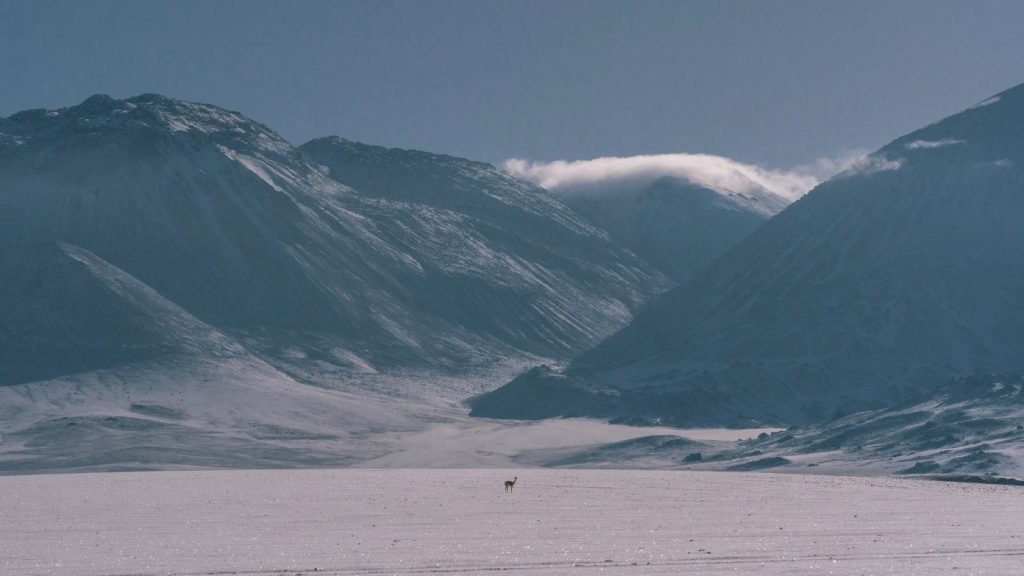
Night frost and light snowfall provide a thin layer of snow on the high plateau at more than 4,000 meters. As soon as it gets light the snow melts quickly and after a few hours, the area turns into a desert again. In the distance, a vicuna is watching us.
The consequences for local ecosystems and their inhabitants are sacrificed by global climate ambitions and the race for dominance over transition minerals. The scale and way mining operates in northern Chile is just one example of where a unique ecosystem and indigenous lifestyles are traded for green growth.
No matter how healthy and resilient these ecosystems are, or how climate-resilient and vulnerable the lives of residents are – that does not stop mining from irreversibly destroying these areas. Unlike the future predictions that climate policy and calculation models of the IPCC focus on, that impact is immediate.
A recent report from the Foundation for Research on Multinational Enterprises (Somo) shows that by 2031 the global production capacity of Li-ion batteries will increase to almost eight thousand GWh. This is enough to power 2.6 million homes for a whole year. Ninety percent of the demand for these batteries will come from the electric vehicle industry, with more than 87 percent expected to be sold in the US, Europe, India, and China.
The true price of electric driving in only a few countries is paid in the Atacama Desert with precious water, food, health, oxygen, and lives of humans and non-humans. “Instead of draining the water and soil here through that mega-industry, we should cherish this earth for the wealth that is there,” concludes Vega.
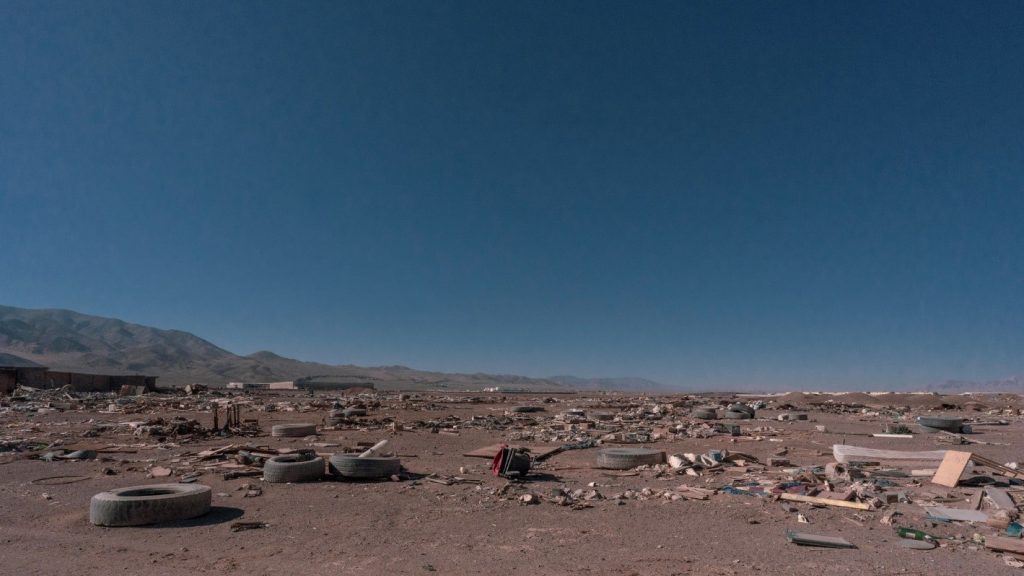
The idea of a desert is for many a dry, empty, and dead area. In reality, little of that is true. But the imaging tends to make it an area and sacrifice zone.
In San Pedro de Atacama, the public space is full of posters. “You will drink lithium and eat copper when there is no more land to abuse.” “The blame is not on the lithium, but on those who benefit from it.” ‘The desert as a wounded body’. It is the work of the local design collective Lagda. When I ask an official about the water level of a local water source, she speaks of “water predators” that threaten life throughout the area, referring to SQM and Albemarle.
The sentiment among many Chileans is that the country is once again being robbed of its mineral wealth by foreign profiteers. Measures that are taken come about under the pressure of overwhelming global demand for raw materials and leave no time or space for a careful dialogue with the local Lickanantay population. Communities are not given a chance to say no to mining, as they should be according to ILO CONVENTION 169.
Some argue that a just transition requires a focus on reducing the material footprint. More and better public transport and a fundamentally different relationship with cars are possible steps in the right direction. But trade agreements that are motivated by a drive for dominance can also hardly serve ‘common values’. In this respect, countries with an industrial lead always come out on top.
The Uruguayan writer and journalist Eduardo Galeano wrote about the bloodletting of the continent of Latin America in the late 1990s. “This is the region of the open veins. Everything, from the discovery to our time, has always been converted into European – or later American – capital, and as such has accumulated in distant centers of power.’ The situation of lithium confirms that this colonial-imperialist practice has a green jacket today.
Darko Lagunas is an environmental sociologist and writer